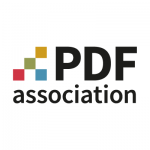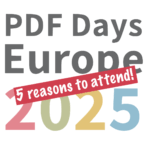PDF/A FAQ

The PDF Association staff delivers a vendor-neutral platform in service of PDF’s stakeholders.


You ask, the PDF Association answers
What is PDF/A, what does it have to offer, and how can I best use it?
Answers to such questions are provided on this page. If you have a question that is not yet addressed here, let us know!
General
If I have PDF/A, do I no longer need paper copies?
The ability to replace paper with electronic documents is a primary goal of PDF/A. Digital documents should remain in electronic format, giving the user a wide range of additional features such as full-text search, digital signatures, and so on.
Up to now we've used "normal" PDF for archiving digital documents. Why is PDF/A better?
PDF/A is an ISO-standardized subset of PDF that eliminates certain risks to the future reproducibility of the content.
Unlike normal PDF, PDF/A requires that everything necessary to precisely rendering the document is contained in the PDF/A file, including fonts, colour profiles, images and so on.
PDF/A forbids dynamic content to ensure that the user sees the exact same content both today and for years to come.
File Formats
How does PDF/A fare with respect to file corruption?
PDF/A is just another file-format, and provides no special protections against data corruption.
Can PDF/A files contain copyright information?
Yes. PDF/A allows users to save various metadata (for example the copyright) in the document using Extensible Metadata Platform (XMP) technology.
How are PDF/A and PDF/X related to each other?
The PDF/A and PDF/X standards are fundamentally compatible; i.e. a PDF file can generally conform to both PDF/A and PDF/X, but for maximum compatibility with modern PDF/X files, PDF/A-2 is highly recommended due to its support for transparency and layers.
Long-term archiving
Will future developments to the PDF/A standard make current PDF/A versions obsolete?
The ISO standard requires that future PDF viewing applications must be backward compatible, so that they are capable of correctly displaying older versions of PDF/A.
PDF/A Characteristics
How can you best make PDF/A files text searchable?
PDF/A files are generally searchable, unless the file was created from a scanned paper document or image. In the case of scanned documents, OCR can be used to create searchable text.
Can PDF/A files include links?
There's no problem with including links in a PDF/A file. It should be considered, however, that external links will likely become invalid over time.
Can audio and video be used in PDF/A files?
PDF/A prohibits audio and video objects in PDF/A files.
Are PDF/A files much larger than normal PDFs?
A PDF/A file might be slightly larger than the original PDF file it was created from (provided they don't use different image resolutions or compression methods). Fonts are embedded in a PDF/A file (which is often also the case in normal PDF files) and more information is stored in the metadata. Some color profiles could, in certain cases, lead to a much larger file size, but this is rare and is highly dependent on the particular case.
Can PDF/A be used with CAD?
PDF/A-3 files may include CAD files as embedded objects.
Is compression allowed in PDF/A?
Yes. ZIP file compression is permitted, and images can be compressed using JPEG compression. LZW compression, however, is forbidden.
Can PDF/A files be encrypted?
No. PDF/A prohibits the use of encryption on the file. For access-control purposes, it is necessary to control access to the locations in which the PDF/A files are stored.
Can bookmarks in a PDF file cause problems in PDF/A?
No. Bookmarks are permitted in PDF/A.
Can PDF/A documents be made "accessible"?
Accessibility and PDF/A go hand-in-hand. PDF/A files may also conform to PDF/UA, the ISO standard for accessible PDF technology.
Can annotations and notes be used in PDF/A files?
Most forms of PDF annotations are permitted in PDF/A. There are certain restrictions; for example any annotations must be visible.
Viewing PDF/A Files
Do I have to purchase an application to display PDF/A files?
No. All PDF viewers are capable of displaying PDF/A files.
Are there any requirements for PDF/A viewing software?
Yes. The PDF/A specification makes certain requirements of viewers that claim support for the PDF/A specification.
Creating and Converting PDF/A
Can "normal" PDF files be converted to PDF/A?
In general, PDF files can be converted to PDF/A. However, depending on the contents of the source PDF and PDF/A target selection, it's possible that some features cannot be transferred to a PDF/A file.
In very general terms, PDF/A-1 is adequate for many archival purposes, especially for scanned documents.
PDF/A-2, which is based on ISO 32000-1, is more flexible, and allows for richer graphics, including transparency and layers, and the embedding of other PDF/A files.
PDF/A-3 is similar to PDF/A-2, but also allows for embedding non-PDF files.
How can I tell if a font is protected by copyright and can't be copied into a PDF/A file?
Usually a program that creates PDF/A files will give a warning if a font file cannot be embedded. The problem is not very prevalent with standard western fonts, since most font developers allow their fonts to be embedded. However, some fonts (including many Japanese fonts) are copyrighted and cannot be embedded.
We currently have an archive of TIFF images. Can these files be converted to PDF/A with a reasonable effort?
There are many solutions available that are geared towards converting large volumes of files (from different formats) into PDF/A.
How can I create a PDF/A file?
In principle, any PDF creation software may also create PDF/A files. In practice, the following scenarios are the most typical:
- Export a document to PDF/A
- Print to PDF/A on a desktop computer
- Print to PDF/A using a print stream on a server
- Scan to PDF/A (paper to PDF/A)
- Convert existing image files to PDF/A
- Convert existing PDF files to PDF/A
- Create PDF/A on-the-fly from data or a database
Check out the many PDF/A solutions developed by PDF Association members to find what's right for you.
PDF/A Validation
How can I find out if a font is embedded?
When a PDF/A file is created, the creation software ensures that fonts are embedded. Many desktop PDF creation and editing tools allow you to determine whether your fonts are embedded or not. Generally speaking, without embedded fonts you don't have a valid PDF/A file. The only exception are fonts where the glyphs are not actually rendered, such as in the case of scanned documents where invisible glyphs are added by OCR software to make the scanned text searchable. In such cases PDF/A permits non-embedded fonts.
Are there programs that check and confirm the validity of a PDF/A file?
There are many such tools, from open source (including the industry-supported veraPDF validator) to commercial solutions.
Signatures
Can PDF/A files contain an electronic signature?
Yes.




